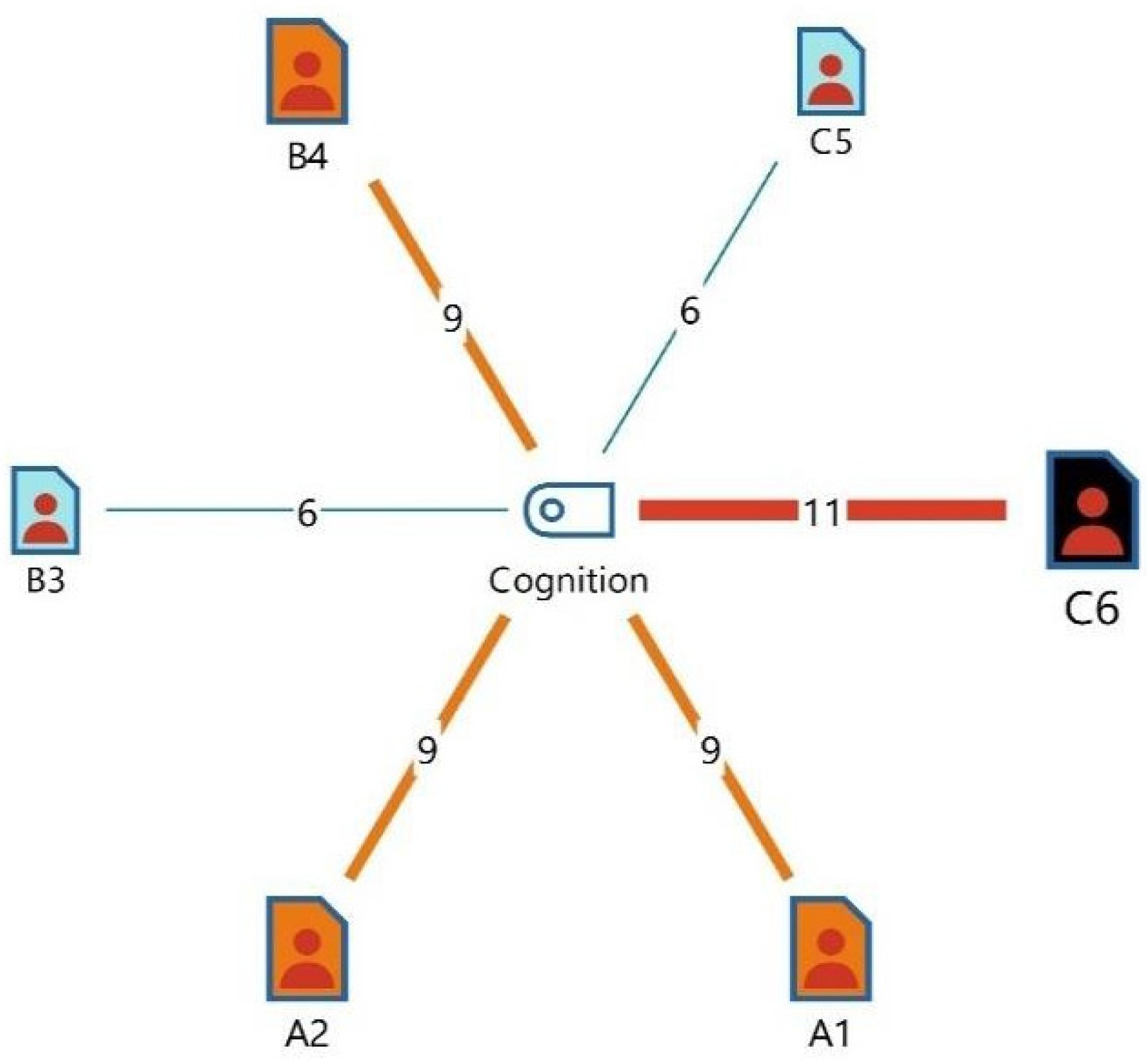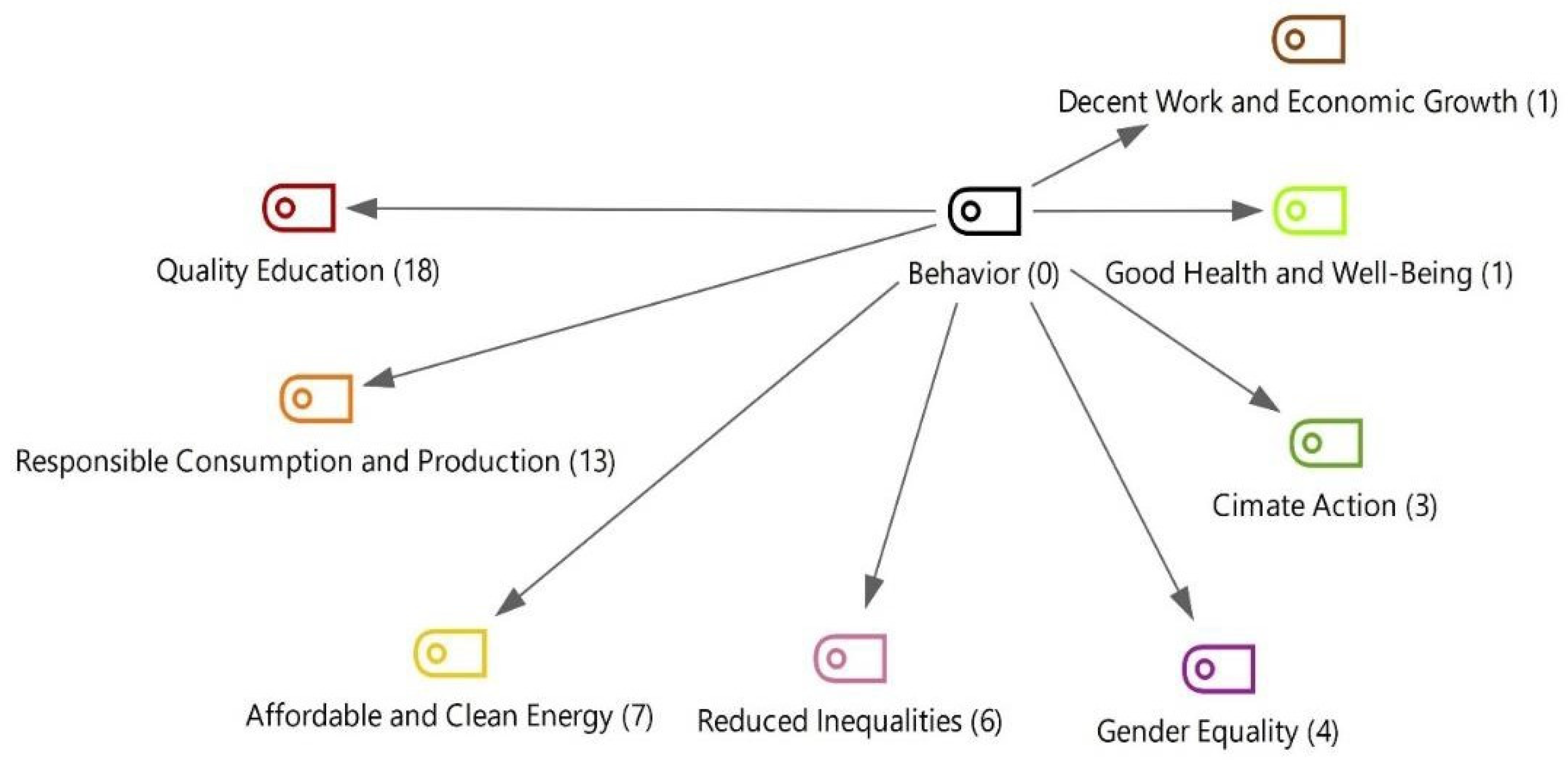Indonesian Vocational Educators’ Cognition and Behavior towards Sustainable Development Goals (SDGs): A Qualitative Study †
Abstract
1. Introduction
1.1. Educator’s Cognition on SDGs
1.2. Educators’ Behavior and SDGs
1.3. Technical and Vocational Education (TVE) as a Proper Instrument for National Sustainable Development
2. Methodology
2.1. Research Subject
2.2. Procedure and Analysis
3. Results and Discussion
“.... Our government still focused on fossil fuel, making the transition to the progress of re- newable energy stagnant. As a result, SDGs are only jargon.”“Need self of belonging to apply SDGs in our life, such as saving energy when in the work- place....”
“I always encourage my student to differentiate medical trash from the others, cause it would be dangerous, this is basic but vital”-Participant A1
“Pandemic brings positive change in students’ habits, now they have to submit assignments online, not using paper anymore......I tried to reduce meat from the farm because I know that roughly 60% of all greenhouse gas emissions come from agricultural agriculture”-Participant B3
4. Conclusions
Author Contributions
Funding
Institutional Review Board Statement
Informed Consent Statement
Data Availability Statement
Conflicts of Interest
References
- Milanovic, B. Global Inequality: A New Approach for the Age of Globalization; Harvard University Press: Cambridge, MA, USA, 2016. [Google Scholar]
- Pecl, G.T.; Araújo, M.B.; Bell, J.D.; Blanchard, J.; Bonebrake, T.C.; Chen, I.C.; Clark, T.D.; Colwell, R.K.; Danielsen, F.; Evengård, B.; et al. Biodiversity redistribution under climate change: Impacts on ecosystems and human well-17 being. Science 2017, 355, eaai9214. [Google Scholar] [CrossRef] [PubMed]
- Gills, B.; Morgan, J. Global climate emergency: After COP24, climate science, urgency, and the threat to humanity. Globalizations 2020, 17, 885–902. [Google Scholar] [CrossRef]
- Akenji, L.; Bengtsson, M.; Bleischwitz, R.; Tukker, A.; Schandl, H. Ossified materialism: Introduction to the special volume on absolute reductions in materials throughput and emissions. J. Clean Prod. 2016, 132, 1–12. [Google Scholar] [CrossRef]
- Labanca, N.; Bertoldi, P. Beyond energy efficiency and individual behaviours: Policy insights from social practice theories. Energy Policy 2018, 115, 494–502. [Google Scholar] [CrossRef]
- Zhou, C.; Etzkowitz, H. Triple helix twins: A framework for achieving innovation and UN sustainable development goals. Sustainability 2021, 13, 6535. [Google Scholar] [CrossRef]
- Lahi, A. Triple Helix, as an acceleration model of Sustainable Development Goals. Eur. J. Econ. Bus. Stud. 2021, 5, 101–105. [Google Scholar] [CrossRef][Green Version]
- Luengo-Valderrey, M.-J.; Pando-García, J.; Periáñez-Cañadillas, I.; Cervera-Taulet, A. Analysis of the impact of the triple helix on sustainable innovation targets in Spanish technology companies. Sustainability 2020, 12, 3274. [Google Scholar] [CrossRef]
- Saviano, M.; Sciarelli, F.; Rinaldi, A.; Alowanou, G.G. Healthcare and SDGs governance in light of the sustainability helix model: Evidence from the African continent. Sustainability 2019, 11, 1203. [Google Scholar] [CrossRef]
- Asmara, A.Y.; Hidayat, A.R.T.; Ohgaki, H.; Mitsufuji, T.; Caballero, J.C. Utilization of solar and wind energy to improve the quality of life for rural communities in Blora Regency–Indonesia: From triple helix to quadruple helix. IOP Conf. Ser. Earth Environ. Sci. 2021, 916, 012036. [Google Scholar] [CrossRef]
- Sutoro, M. Reality of Lecturers’ Performance, What’s Next? In Proceedings of the 1st International Conference on Research in Social Sciences and Humanities (ICoRSH 2020), Virtual, 28 October 2020; pp. 320–324. [Google Scholar]
- Copeland, T.J.; Dengah, H.J.F. ‘Involve me and I learn’: Teaching and applying anthropology. Ann. Anthropol. Pract. 2016, 40, 120–133. [Google Scholar] [CrossRef]
- Maipita, I.; Dalimunthe, M.B.; Sagala, G.H. The Development Structure of the Merdeka Belajar Curriculum in the Industrial Revolution Era. In Proceedings of the International Conference on Strategic Issues of Economics, Business and, Education (ICoSIEBE 2020), online, 1–2 December 2021; pp. 145–151. [Google Scholar]
- Couper, G. Teacher cognition of pronunciation teaching: Teachers’ concerns and issues. Tesol. Q. 2017, 51, 820–843. [Google Scholar] [CrossRef]
- Schulman, L.S. Paradigms and research programs in the study of teaching. In Handbook of Research on Teaching; Macmillan: New York, NY, USA, 1986; pp. 3–36. [Google Scholar]
- Vygotsky, L.S. Thought and Language-Revised Edition; Massachusetts Institute of Technology: Cambridge, MA, USA, 1986. [Google Scholar]
- Kwee, C.T.T. I want to teach sustainable development in my English classroom: A case study of incorporating sustainable development goals in English teaching. Sustainability 2021, 13, 4195. [Google Scholar] [CrossRef]
- Biasutti, M.; Makrakis, V.; Concina, E.; Frate, S. Educating academic staff to reorient curricula in ESD. Int. J. Sustain. High. Educ. 2018, 19, 179–196. [Google Scholar] [CrossRef]
- Filho, W.L. Living labs for sustainable development: The role of the European school of sustainability sciences and research. In Universities as Living Labs for Sustainable Development; Springer: Berlin/Heidelberg, Germany, 2020; pp. 3–9. [Google Scholar]
- Fındık, L.Y.; Bayram, I.; Canaran, Ö. Pre-service English language teachers’ conceptions of sustainable development: A case from Turkish higher education context. Int. J. Sustain. High. Educ. 2021, 22, 423–456. [Google Scholar] [CrossRef]
- Epstein, S. Cognitive-Experiential Self-Theory, [w:]. In Handbook of Personality and Research: Theory and Research, (red.) Pervin LA; Guilford Publications, Inc.: New York, NY, USA, 1990. [Google Scholar]
- Chawla, L. Significant life experiences revisited: A review of research on sources of environmental sensitivity. J. Environ. Educ. 1998, 29, 11–21. [Google Scholar] [CrossRef]
- Klein, S.S. Student influence on teacher behavior. Am. Educ. Res. J. 1971, 8, 403–421. [Google Scholar] [CrossRef]
- Chen, M.; Jeronen, E.; Wang, A. Toward environmental sustainability, health, and equity: How the psychological characteristics of college students are reflected in understanding sustainable development goals. Int. J. Environ. Res. Public Health 2021, 18, 8217. [Google Scholar] [CrossRef]
- Kehinde, T.M.; Adewuyi, L.A. Vocational and technical education: A viable tool for transformation of the Nigerian economy. Int. J. Vocat. Tech. Educ. Res. 2015, 1, 22–31. [Google Scholar]
- Goel, V.P.; Vijay, P. Technical and Vocational Education and Training (TVET) System in India for Sustainable Development; UNEVOC: Bonn, Germany, 2011. [Google Scholar]
- Malley, J.; Keating, J. Policy influences on the implementation of vocational education and training in Australian Secondary Schools1. J. Vocat. Educ. Train. 2000, 52, 627–652. [Google Scholar] [CrossRef]
- Wardiman, D. Pengembangan Sumber Daya Manusia: Melalui Sekolah MenengahKejuruan (SMK); PT Balai Pustaka: Jakarta, Indonesia, 1998. [Google Scholar]
- Gessler, M. The lack of collaboration between companies and schools in the German dual apprenticeship system: Historical background and recent data. Int. J. Res. Vocat. Educ. Train. (IJRVET) 2017, 4, 164–195. [Google Scholar] [CrossRef]
- Kvale, S.; Brinkmann, S. Den Kvalitativa Forskningsintervjun (Torhell, SE. Övers.); Originalarbete publicerat 2009; Studentlitteratur: Lund, Switzerland, 2009. [Google Scholar]
- Morse, J.M.; Richards, L. Readme First for a User’s Guide to Qualitative Methods; SAGE Publications, Incorporated: New York, NY, USA, 2002. [Google Scholar]
- Consoli, S. Uncovering the hidden face of narrative analysis: A reflexive perspective through MAXQDA. System 2021, 102, 102611. [Google Scholar] [CrossRef]
- Ghorbani, S.; Jafari, S.E.M.; Sharifian, F. Learning to Be: Teachers’ Competences and Practical Solutions: A Step towards Sustainable Development. J. Teach. Educ. Sustain. 2018, 20, 20–45. [Google Scholar] [CrossRef]
- Suranovic, S. Fossil fuel addiction and the implications for climate change policy. Glob. Environ. Change 2013, 23, 598–608. [Google Scholar] [CrossRef]
- May, V. Self, belonging and social change. Sociology 2011, 45, 363–378. [Google Scholar] [CrossRef]
- Johnson, R.E.; Chang, C.-H.; Lord, R.G. Moving from cognition to behavior: What the research says. Psychol. Bull. 2006, 132, 381. [Google Scholar] [CrossRef]
- Okubo, K.; Yu, J.; Osanai, S.; Serrona, K.R.B. Present issues and efforts to integrate sustainable development goals in a local senior high school in Japan: A case study. J. Urban Manag. 2021, 10, 57–68. [Google Scholar] [CrossRef]
- Pallant, E.; Choate, B.; Haywood, B. How do you teach undergraduate university students to contribute to UN SDGs 2030? In Universities as Living Labs for Sustainable Development; Springer: Berlin/Heidelberg, Germany, 2020; pp. 69–85. [Google Scholar]
- Biesta, G.J.J. Beautiful Risk of Education; Routledge: London, UK, 2015. [Google Scholar]


| No. | University Name (Hidden) | Province | Overall Best Scores by Rank |
|---|---|---|---|
| 1 | Univ A | West Java | 92.4 |
| 2 | Univ B | The Special Region of Yogyakarta | 89.2 |
| 3 | Univ C | East Java | 72.0–76.7 |
| Participant and Institution | Gender | Profession | SDGs Dimension |
|---|---|---|---|
| A1 (Univ A) | Male | Lecturer in Hospital Administration | Socio-Cultural Dimension |
| A2 (Univ A) | Female | Lecturer in Accounting Costs | Economic Dimension |
| B3 (Univ B) | Female | Lecturer in Applied English Language | Socio-Cultural Dimension |
| B4 (Univ B) | Male | Lecturer in Rapid Prototyping/ Engineering Design | Environmental Dimension |
| C5 (Univ C) | Male | Lecturer in Industrial Mechanical Engineering | Environmental Dimension |
| C6 (Univ C) | Male | Lecturer in Infrastructure Engineering | Environmental Dimension |
| Name | Institution | Position | Expert Field |
|---|---|---|---|
| Expert 1 | SF univ (Canada) | Professor | Organizational Behavior and Executive Education |
| Expert 2 | FUM (Iran) | Assistant Professor | Educational Administration |
| Expert 3 | NWU (South Africa) | Professor | Multimodal Learning and Multilingualism in Education |
| Expert 4 | DCU (Ireland) | Professor | Educational Evaluation |
Disclaimer/Publisher’s Note: The statements, opinions and data contained in all publications are solely those of the individual author(s) and contributor(s) and not of MDPI and/or the editor(s). MDPI and/or the editor(s) disclaim responsibility for any injury to people or property resulting from any ideas, methods, instructions or products referred to in the content. |
© 2022 by the authors. Licensee MDPI, Basel, Switzerland. This article is an open access article distributed under the terms and conditions of the Creative Commons Attribution (CC BY) license (https://creativecommons.org/licenses/by/4.0/).
Share and Cite
Wibowo, R.A.; Liu, W.-T. Indonesian Vocational Educators’ Cognition and Behavior towards Sustainable Development Goals (SDGs): A Qualitative Study. Proceedings 2022, 83, 11. https://doi.org/10.3390/proceedings2022083011
Wibowo RA, Liu W-T. Indonesian Vocational Educators’ Cognition and Behavior towards Sustainable Development Goals (SDGs): A Qualitative Study. Proceedings. 2022; 83(1):11. https://doi.org/10.3390/proceedings2022083011
Chicago/Turabian StyleWibowo, Radna Andi, and Wei-Te Liu. 2022. "Indonesian Vocational Educators’ Cognition and Behavior towards Sustainable Development Goals (SDGs): A Qualitative Study" Proceedings 83, no. 1: 11. https://doi.org/10.3390/proceedings2022083011
APA StyleWibowo, R. A., & Liu, W.-T. (2022). Indonesian Vocational Educators’ Cognition and Behavior towards Sustainable Development Goals (SDGs): A Qualitative Study. Proceedings, 83(1), 11. https://doi.org/10.3390/proceedings2022083011






